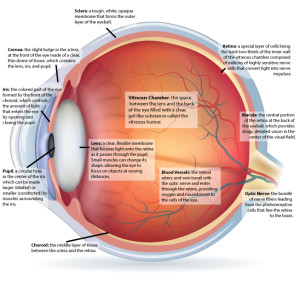Posted by: Georgia Eye Physicians and Surgeons in Latest News
Here at Georgia Eye Physicians & Surgeons, we know that the eyes are among the most complex and sensitive organs in the body, but we don’t often talk about exactly what that means. Although most people take them for granted, the eyes are actually made up of more than 200 million working parts, all working together to collect and process visual information so that it can be interpreted by the brain. Understanding how the eyes work gives us some fascinating insight into how much they can really do.
Basically, the eyes detect, and differentiate between, the different wavelengths of the electromagnetic energy that is all around us. However, they do not detect ALL such energy; in fact they screen out the vast majority of it. Human eyes are NOT sensitive enough to detect low frequency radio waves and micro-waves, which are used to transmit cellular communication, nor can they perceive high frequency x-rays and gamma rays, which can potentially cause cellular damage. Instead, our perceptions are limited to a tiny band near the middle of this range that we call “visible light.”
How Many Colors Can We See?
Sensitive cells that line the retina at the back of the eye perceive lower frequency visible light as red or orange in color and higher frequency light as blue or violet, with yellow and green falling in between. Even within that relatively narrow range, the average human eye can distinguish between about a million different color shades. However, color perception varies from person to person. Some can distinguish many times that number, while others may experience differing degrees of color blindness.
How Small and How Far Can We See?
Under the right conditions, there is really no absolute range on how far we can see. If even the smallest amount of light can reach the eye, our brain will register that we saw something. However, our ability to make out small detail is a little less acute. On a clear dark night, the human eye can detect the light of a single candle from about 14 miles away, but in terms of resolution, the best we can do is about 120 pixels per degree of arc, a unit of angular measurement. That would work out to about 576 megapixels, if the eye were a digital camera. By way of comparison, the camera on the iPhone 6 has 8-megapixel resolution and the highest quality professional digital cameras have, at most, around 80.
How Strong Are the Eyes?
While we often don’t give the muscles that control eye movement and focus much thought, they are actually, relative to their size, among the strongest and most active muscles in the human body. More than one hundred times stronger than they need to be to perform their basic functions, the eye muscles can maintain a state of tension for hours at a time, allowing you to focus on detailed tasks without interruption. Despite their remarkable strength, however, the eyes can become fatigued when forced to maintain focus too long on a single task, a condition commonly known as eye strain.
The eyes are truly remarkable, but all that complexity and sophistication can also sometimes make them prone to problems. That is one of the most important reasons why we recommend that our patients undergo comprehensive medical eye examinations in addition to routine vision exams on a regular basis. If you are having difficulty with your vision, or if you are interested in scheduling an appointment for an eye exam, please contact Georgia Eye Physicians & Surgeons and be sure to follow us on Facebook, Twitter, and Google+ for more tips for healthy eyes.


